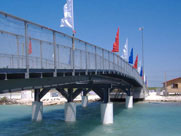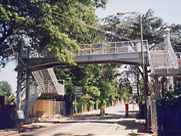How to Make Bridges Flood Resistant
In a flood, the level of the water around the bridge rises, and the speed increases. Not only that, but trees and other debris are carried downstream. Damage happens for several interlinked reasons:
- Large floating lumps can impact the bridge with a lot of energy.
- Floating debris will accumulate upstream of the bridge, and underneath and even over it. The debris applies a pressure on the bridge pushing it downstream, and lifting it up.
- The debris reduces the cross sectional area of the flow at the bridge, which increases the water height upstream, and increases the water speed around the bridge abutments and piers.
- The water speed scours the river bed underneath and around the bridge, undercutting the piers and abutments.
- The water level rises on the approach roads, cutting through the roadway, undermining the abutments and destroying the wingwalls.
Then the bridge fails: because parts of the structure are damaged, because the pressure on the side of the bridge breaks the horizontal bracing system, because uplift lifts it off the bearings, because the pressure of the water can push the whole structure downstream, because piers or abutments are undercut and fall down, dropping the bridge into the river, because the approach roads on either side are cut through.
So how do we design bridges to resist floods?
The first step is to keep the deck above the level of the flood, so we make the lowest part of the bridge higher. A through-truss or stayed bridge does not have much structure below the roadway. The depth of the roadway is reduced to a minimum so that water can flow through it. We would like to have a concrete deck on our steel, because it is much heavier than a wood or metal deck, and will resist uplift; and because the concrete deck makes an excellent shear resisting member, making it difficult to bend the bridge sideways. If possible, the bridge is clear span, so there are no piers to undercut. The abutments should be well protected below and above normal water levels to prevent erosion. If the bridge is on a wide flood plain, the bridge deck and the abutments should be higher than the surrounding land, with a ramp up at both ends, and in this way the flood is relieved by going around the bridge: it is much easier to fill a hole in the approach road than to replace a bridge.
REIDsteel highway bridges can be made up to 200m span. A large part of the cost of a bridge is the design process, but our bridges are pre-designed for a number of different spans and widths, so much of the cost can be avoided. Our bridges have 'lost formwork' on which it is easy to pour a thick strong heavy concrete slab. We can design them to be transported and assembled using light equipment in a variety of differing gap shapes.
Describe your bridge problem with us by email.
Contact Us for more flood protection advice.










